Microsoft is making its Office Suites free—but there’s a catch

Well, it finally happened. Ads have taken over everything. They’re in our streaming services, our mobile games, even our social media feeds. And now, Microsoft has done the unthinkable: put ads in Office.
Microsoft has quietly rolled out a free version of Office for Windows, letting you edit documents without paying for a Microsoft 365 subscription. Sounds great, right? Well… not so fast.
While this new free version technically lets you open, edit, and create Word, Excel, and PowerPoint files, it comes with a major catch: ads. Permanent, unskippable, always-there ads.
If you thought the little pop-ups in free mobile apps were annoying, imagine trying to draft an important report with a banner ad just chilling in the corner of your screen. And as if that wasn’t bad enough, a 15-second video ad plays every few hours. It’s muted, but still—why does my word processor need commercial breaks?
And it gets worse. You can’t save files locally—everything has to go through OneDrive. And in case you were hoping to get some real work done, Microsoft has also locked away a ridiculous number of features behind a paywall.
For example, in Microsoft Word, no custom line spacing, no headers or footers, no advanced formatting. You can’t even hyphenate words anymore. Beebom counted over 30 missing features for each of the Office apps, and at this point, it barely feels like Office at all.
So who is this for, exactly? The only real reason that comes to mind is if you use Office for professional work and you absolutely need full compatibility with Microsoft’s ecosystem—but at that point, you might as well just pay for the subscription. If you just need a basic word processor, Google Docs exists. Even LibreOffice is free and doesn’t shove ads in your face.
Oddly, Microsoft hasn’t even officially announced this version. Just a quiet rollout to see people's reactions. Or it is a strategy to slowly introduce ads into the Windows experience.
Either way, it’s clear that “free” doesn’t mean what it used to. Want to use Office without paying? Sure, go ahead. But in return, Microsoft gets to monetize your eyeballs. Whether or not that’s a trade-off you’re willing to make, that’s up to you.

